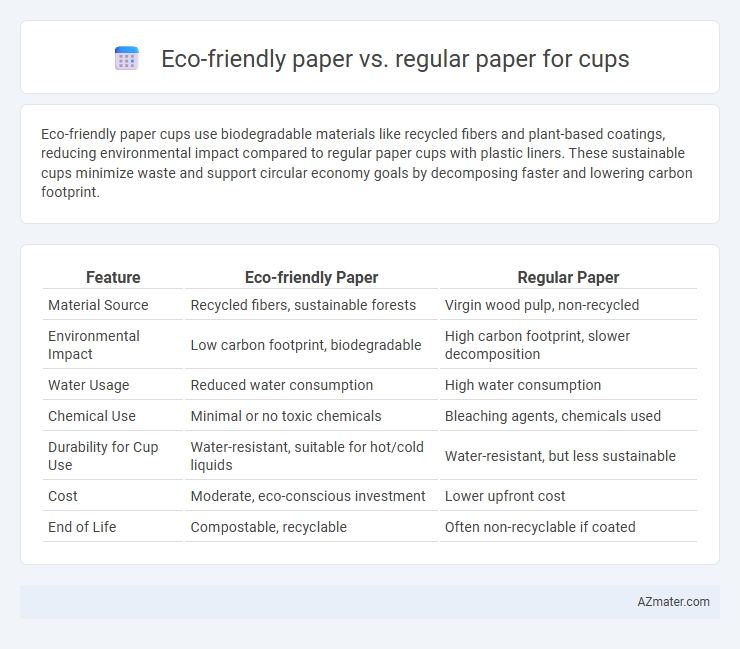Eco-friendly paper cups use biodegradable materials like recycled fibers and plant-based coatings, reducing environmental impact compared to regular paper cups with plastic liners. These sustainable cups minimize waste and support circular economy goals by decomposing faster and lowering carbon footprint.
Table of Comparison
| Feature | Eco-friendly Paper | Regular Paper |
|---|---|---|
| Material Source | Recycled fibers, sustainable forests | Virgin wood pulp, non-recycled |
| Environmental Impact | Low carbon footprint, biodegradable | High carbon footprint, slower decomposition |
| Water Usage | Reduced water consumption | High water consumption |
| Chemical Use | Minimal or no toxic chemicals | Bleaching agents, chemicals used |
| Durability for Cup Use | Water-resistant, suitable for hot/cold liquids | Water-resistant, but less sustainable |
| Cost | Moderate, eco-conscious investment | Lower upfront cost |
| End of Life | Compostable, recyclable | Often non-recyclable if coated |
Introduction to Cup Material Choices
Eco-friendly paper cups are made from renewable resources like bamboo, sugarcane, or recycled fibers, reducing environmental impact through lower carbon emissions and enhanced biodegradability. Regular paper cups are typically coated with polyethylene, which provides durability but results in limited recyclability and increased landfill waste. Choosing eco-friendly paper materials supports sustainable consumption by minimizing plastic pollution and promoting compostable alternatives in the beverage industry.
What is Eco-Friendly Paper?
Eco-friendly paper for cups is made from sustainable materials like recycled fibers or sustainably sourced wood, minimizing environmental impact through reduced deforestation and lower carbon emissions. It often incorporates biodegradable coatings such as PLA (polylactic acid) instead of traditional plastic linings, enhancing compostability and recyclability. Compared to regular paper, eco-friendly paper supports circular economy principles by reducing landfill waste and promoting resource conservation.
Regular Paper: Composition and Features
Regular paper cups are primarily made from virgin wood pulp treated with a polyethylene lining to prevent liquid absorption, ensuring sturdiness and moisture resistance. The polyethylene coating, while effective in creating a waterproof barrier, makes these cups difficult to recycle due to mixed material composition. This combination of materials offers durability and low production costs but compromises environmental sustainability compared to eco-friendly alternatives.
Environmental Impact Comparison
Eco-friendly paper cups significantly reduce environmental impact by using biodegradable materials and recycled fibers, lowering deforestation rates and decreasing landfill waste compared to regular paper cups made from virgin pulp and coated with plastic liners. The production of eco-friendly paper cups emits fewer greenhouse gases and consumes less water, enhancing sustainability and minimizing carbon footprint throughout the manufacturing process. Regular paper cups, often non-recyclable due to plastic coatings, contribute to persistent environmental pollution and slow degradation, exacerbating waste management challenges worldwide.
Manufacturing Processes Explained
Eco-friendly paper cups are produced using sustainable raw materials like recycled fibers or biodegradable plant-based components, minimizing environmental impact during manufacturing. Their production involves fewer chemical treatments and reduced energy consumption compared to regular paper cups, which often rely on virgin wood pulp and plastic coatings for durability. Advanced processes such as water-based lamination and eco-friendly inks further distinguish eco-friendly paper cups from conventional ones by enhancing recyclability and compostability.
Biodegradability and Compostability
Eco-friendly paper cups are typically made from renewable resources and coated with biodegradable materials such as PLA (polylactic acid), allowing them to break down naturally within 90 to 180 days in industrial composting conditions. In contrast, regular paper cups often contain polyethylene linings that hinder biodegradability, causing them to persist in landfills for years. Compostability standards like ASTM D6400 and EN 13432 certify eco-friendly cups for safe integration into organic waste streams, promoting reduced environmental impact.
Cost Analysis: Eco-Friendly vs Regular Paper
Eco-friendly paper cups typically have a higher upfront cost due to sustainable materials such as recycled fibers or compostable coatings, while regular paper cups are generally cheaper because of mass production using non-recycled kraft paper and polyethylene liners. However, eco-friendly cups can lower long-term expenses by reducing waste disposal fees and meeting regulatory compliance in markets with strict environmental policies. Cost efficiency also depends on volume, supplier pricing, and consumer demand for sustainability, which can drive competitive pricing for eco-friendly options over time.
Performance and Durability in Use
Eco-friendly paper cups, often made from recycled fibers or biodegradable materials, demonstrate comparable performance to regular paper cups in holding hot and cold beverages without compromising structural integrity. These sustainable alternatives exhibit enhanced durability due to advanced coatings like PLA (polylactic acid), which improves water resistance and prevents leaks during typical use. Regular paper cups may have stronger resistance to grease and moisture but often lack the environmental benefits and biodegradability of eco-friendly options without sacrificing performance.
Consumer Perception and Market Trends
Eco-friendly paper cups are increasingly favored by consumers due to their biodegradable materials and lower environmental impact, aligning with growing sustainability awareness. Market trends show a significant rise in demand for compostable and recyclable cup options, driven by regulatory pressures and eco-conscious branding. Consumer perception shifts towards valuing transparency and certifications, such as FSC and USDA Organic, which influence purchasing decisions in the beverage container sector.
Choosing the Best Paper for Cups
Eco-friendly paper cups, made from renewable resources and often biodegradable, reduce environmental impact compared to regular paper cups lined with plastic, which contribute significantly to landfill waste. Choosing the best paper for cups requires evaluating factors like durability, insulation, recyclability, and compostability to meet both consumer convenience and sustainability goals. Advances in eco-friendly coatings using plant-based materials provide a viable alternative to traditional polyethylene linings, enhancing the cup's performance without compromising its environmental benefits.

Infographic: Eco-friendly paper vs Regular paper for Cup
 azmater.com
azmater.com